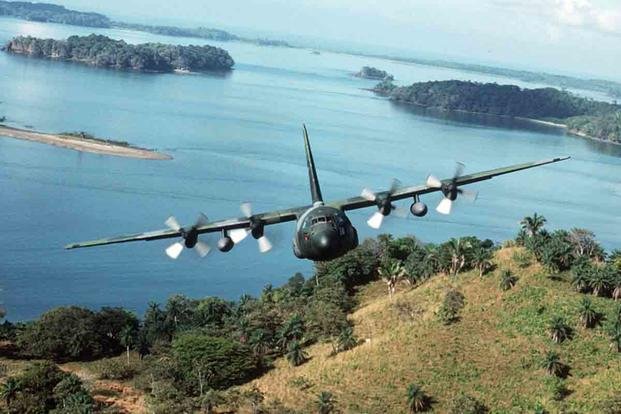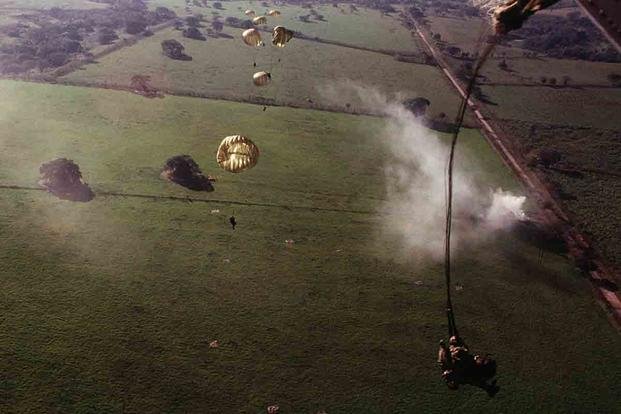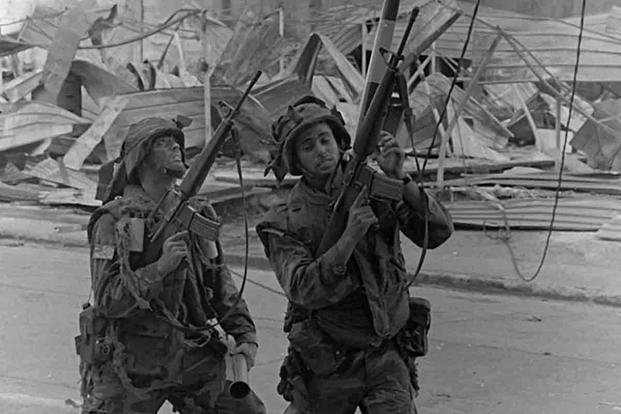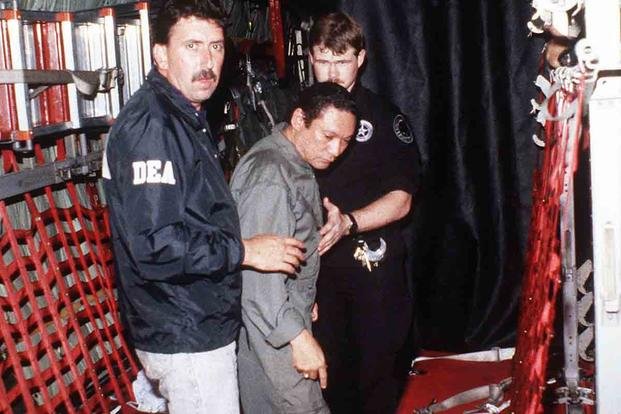Operation Just Cause, the United States' invasion of Panama, was a long time coming. Critics of the invasion denounced it as an illegal military action, but the U.S. cited evidence Panamanian dictator Manuel Noriega was actively aiding drug cartels. The United States also still maintained a lot of assets in the Panama Canal Zone, which were beginning to be threatened by Noriega's increasing paranoia.
The invasion of Panama was supposed to come after a slow buildup of American forces in the canal zone and the region, but the timeline was accelerated after the mistreatment of American citizens and U.S. military members.
On Dec. 16, 1989, four U.S. service members were stopped by the Panamanian Defense Forces (PDF) on their way to dinner in Panama City. The previous day, Panama's government had declared a state of war existed between the two countries, which was dismissed as bluster. After the vehicle was stopped, shots were fired by the PDF, which killed one and wounded another.
That was enough for President George H.W. Bush. He ordered the U.S. military to launch an invasion of Panama to protect Americans, U.S. military assets in the Panama Canal Zone and to capture Noriega. Bush’s justification was enough for Congress to authorize the move.
What Was Operation Just Cause?

President Bush outlined four objectives for the Invasion of Panama. The first was to protect U.S. citizens in the country. There were an estimated 35,000 Americans living, working and doing business in the country, not just the American personnel stationed there. Furthermore, the U.S. wanted to restore democratic and human rights for Panamanians, which were increasingly restricted by Noriega's rule.
Though Noriega had originally been a CIA asset in the ongoing U.S. War on Drugs, he had slowly begun to work more in favor of drug traffickers, allowing safe harbor for drug shipments and the use of Panamanian banks to launder money.
Finally, Bush had hoped to uphold the timeline and neutrality demanded by the Torrijos-Carter Treaties that would return the Panama Canal to Panamanian control. Bush claimed Noriega was threatening to weaponize control of the canal and that the treaty allowed for military intervention.
At 1 a.m. on Dec. 20, 1989, a joint force of nearly 26,000 American troops descended on Panama, bringing with them new vehicles and technology they'd never used before. It was the trial by fire for the AH-64 Apache helicopter, the HMMWV (or Humvee) and F-117A Nighthawk stealth aircraft.
The U.S. Invasion of Panama
American assets began the invasion of Panama by capturing Punta Paitilla Airport near Panama City. Elements of SEAL Team Four destroyed Noriega's personal private jet on the ground at the airport while SEAL Team Two conducted a combat swimmer attack on his private gunboat, Presidente Porras. Noriega was effectively trapped inside Panama.
Throughout the country, American forces attacked an estimated two dozen key PDF military centers, including La Comandancia, the Panamanian military's central headquarters, in the most complex operation since the Vietnam War. They were facing 12,800 Panamanian troops, but only an estimated 4,000 were ready for combat.
The expected centers of resistance to the invasion were La Comandancia; Fort Cimarron, 15 miles east of the capital; Torrijos-Tocumen Airport; Fort Espinar in the Colón area; around 400 troops near Rio Hato; and Fort Amador, near the Bridge of the Americas, southwest of Panama City. The American attack happened near simultaneously.

At Rio Hato, F-117A Nighthawks dropped a 2,000-pound bomb between the two barracks housing hundreds of PDF troops. Army Rangers of Task Force RED and elements of the 82nd Airborne parachuted into the area in the largest airborne operation since World War II. This operation isolated Panama City from the rest of the PDF, but the fight at Rio Hato lasted five hours.
Meanwhile, U.S. forces inside Panama City assaulted La Comandancia; in less than an hour, the headquarters was surrounded, and the building was effectively neutralized. Forty-five minutes after the invasion began, other elements of the 82d Airborne were landing at Torrijos-Tocumen Airport and were soon backed by more Rangers.
Conventional forces from the U.S. Army's 7th Infantry captured Colón while U.S. Marines captured PDF stations in the western suburbs of the Panamanian capital. It also secured the flanks of Howard Air Force Base.
The most difficult task fell to Task Force Bayonet, made up of four Sheridan armored vehicles, three battalions of infantry and four helicopter gunships. Its mission was to fight its way through Panama City to capture Fort Amador, then continue on to seize La Comandancia, all while protecting the U.S. embassy. The embassy began taking rocket and mortar fire just a half-hour after hostilities commenced.

PDF troops made a stand in defending La Comandancia, where a firefight raged for three hours. In that time, the defenders took down two special operations helicopters and forced an observation helicopter to ditch into the Panama Canal.
In the end, Apache helicopters fired a hellfire missile into the building. After that, the Panamanians could no longer control their forces. Fighting was sporadic across the city and the country as a whole. Operation Just Cause was over in less than six weeks.
Rescuing an American Citizen
At the same moment the U.S. launched its invasion, the U.S. Army's Delta Force launched a daring raid on Noriega's Carcel Modelo prison, close to the Comandancia building. Kurt Muse, an American who was living in Panama, had been held there for nine months before Operation Just Cause was launched. Muse was essentially a hostage, and Noriega promised the first Panamanian bullet fired in a war would be aimed at him.
Read: Operation Acid Gambit: How Army Special Forces Rescued an American Hostage in Noriega's Panama
Delta Force soldiers entered through the prison's rooftop and fought their way to Muse's cell. Luckily, the guard meant to kill the hostage had fled. After taking Muse on board one of their MH-6 Little Bird helicopters, they headed back to Howard Air Force Base. The Little Bird carrying Muse was one of the helicopters shot down by the PDF defenders of La Comandancia.
They all survived the crash landing, but were forced to take cover in a nearby treeline until they were retrieved by the Sheridan armored personnel carriers. Muse was rescued, and soon after, he was returned to his family.
Capture of Manuel Noriega
With no way out of Panama, Noriega fled. By the fifth day of the invasion, he was given sanctuary inside the Apostolic Nunciature of the Holy See, the de facto embassy of the Vatican. Without consulting the Pope, the Nunciature agreed, believing it was their duty to convince him to surrender. Instead, Noriega and four of his closest associates hid inside. American troops, unable to enter the grounds, set up a perimeter outside.
When the Holy See refused to force Noriega off the ground, the Army began blasting high-volume music at the building throughout the day and night, using "You Shook Me All Night Long" by AC/DC, The Clash's "I Fought the Law" and "Welcome to the Jungle" by Guns N' Roses. The music went on for three days. It stopped after the Vatican complained to the United States.
On Jan. 3, 1990, Noriega dressed in a tan uniform and walked out to meet the soldiers at the gates of the Nunciature's grounds. He was arrested and taken back to Howard Air Force Base, his first stop before being extradited to the U.S. on drug charges. Guillermo Endara was sworn into office. Endara had won an election against pro-Noriega factions in May 1989, but Noriega nullified the election.

Noriega was sentenced to 40 years in prison in the U.S., extradited to France for trial and imprisonment and then extradited to Panama to face murder charges. He was sentenced to another 60 years in prison, where he died during surgery to remove a brain tumor in 2017.
-- Blake Stilwell can be reached at blake.stilwell@military.com. He can also be found on Twitter @blakestilwell or on Facebook.
Want to Learn More About Military Life?
Whether you're thinking of joining the military, looking for post-military careers or keeping up with military life and benefits, Military.com has you covered. Subscribe to Military.com to have military news, updates and resources delivered directly to your inbox.
















